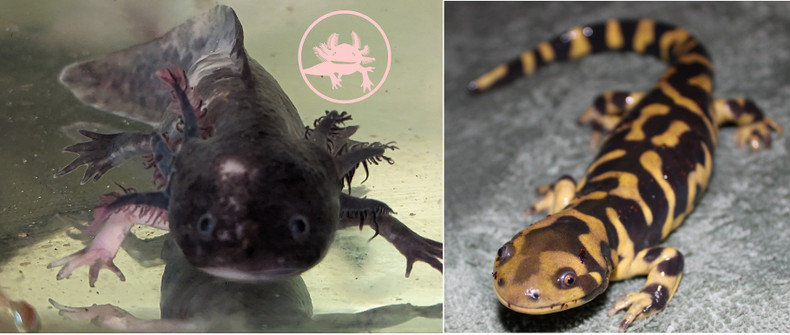Nature never ceases to amaze us with its incredible diversity of creatures, and among them, amphibians hold a special place. Two fascinating amphibians that often capture the attention of enthusiasts and researchers alike are the axolotl and the salamander. While they share similarities, such as being part of the same animal class, Amphibia, there are distinct differences that set them apart. In this article, we will explore the unique characteristics and contrasting features of the axolotl and the salamander.
1. Appearance: The most striking difference between axolotls and salamanders lies in their physical appearance. Axolotls have a unique and captivating appearance, with their neotenic features. They retain their larval form throughout their lives, which means they do not undergo metamorphosis into adults. They possess external gills and a fin-like tail that extends along the length of their body. In contrast, salamanders typically undergo metamorphosis, transitioning from aquatic larvae with gills to terrestrial adults with lungs. Adult salamanders generally have a more elongated body shape, four limbs, and a distinct tail.
2. Habitat: Another notable distinction between the axolotl and the salamander is their natural habitat. Axolotls are native to the Xochimilco region of Mexico, where they inhabit high-altitude lakes and canals. They are fully aquatic and primarily reside in freshwater environments. Salamanders, on the other hand, display a wider range of habitat preferences. While many species are also found in freshwater habitats, others inhabit terrestrial or semi-aquatic environments, such as forests, mountains, or underground burrows.
3. Reproduction: Reproductive strategies greatly differ between these two amphibians. Axolotls exhibit an exceptional ability known as neoteny, allowing them to retain their juvenile characteristics and reproductive abilities throughout their lives. They reproduce by laying eggs, and their mating rituals involve complex courtship displays. Salamanders, in contrast, typically undergo metamorphosis and experience a transition from aquatic larvae to terrestrial adults. They reproduce through a variety of methods, including external fertilization, internal fertilization, or retaining eggs within the female's body until they hatch.
4. Regeneration: One of the most remarkable features of axolotls is their exceptional regenerative abilities. They possess an astonishing capacity to regrow lost body parts, including limbs, spinal cord, heart tissue, and even parts of their brain. This regenerative potential is significantly higher compared to salamanders. While salamanders also possess regenerative abilities, they are typically more limited, and the extent of regeneration varies among species.
5. Conservation Status: The conservation status of these two amphibians diverges significantly. Axolotls face severe threats in their natural habitat and are listed by the IUCN Red List as critically endangered in the wild. Environmental degradation, habitat loss, and pollution have taken a toll on their population numbers. In contrast, the conservation status of salamanders varies among species. While some are listed as endangered or vulnerable, many others have stable populations and are not currently facing significant conservation concerns.
In conclusion, the axolotl and the salamander are fascinating amphibians with distinct characteristics. The axolotl captivates with its neotenic features, fully aquatic lifestyle, and remarkable regenerative abilities. In contrast, the salamander showcases the wonders of metamorphosis, a broader range of habitats, and diverse reproductive strategies. Understanding the differences between these two creatures adds to our appreciation of the incredible diversity of life on our planet.
Check out live axolotls for sale at www.TheMottledLotl.com

